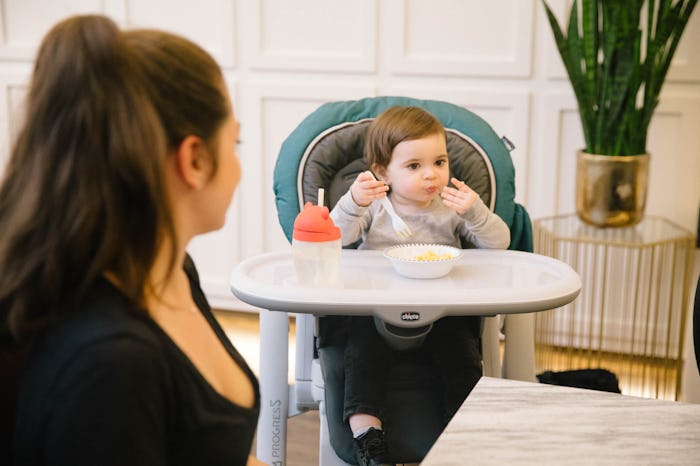Life
What A Pediatrician *Really* Wants You To Know About Baby-Led Weaning
Parenting is full of transitions. And it's not uncommon that once you get the hang of a phase, your little one is on to the next. Keeps things lively, right? But the list of questions is large when it comes time to adding solid foods to their diet. There's choosing between sweet and savory, considering homemade and store bought options, and, of course, choosing how you will introduce it to them. Some parents opt for traditional purées, while others choose baby-led weaning. But while you are probably familiar with purées, you might be wondering: Is baby-led weaning safe?
Dr. Gina Posner, a pediatrician at MemorialCare Orange Coast Medical Center in Fountain Valley, California, tells Romper in an email interview that she has "very mixed feelings on baby-led weaning." That's because, like many things (especially when it comes to parenting), there are pros and cons to baby-led weaning which, in short, involves skipping the starter purées and offering foods that are soft-cooked and cut or mashed into small pieces instead.
"I do agree that babies sometimes develop an aversion to textures when they are constantly fed purées," Posner says. "It is also great for them to learn to feed themselves."
But Posner says her main concern with baby-led weaning is that many babies are not ready for chunks of food (even soft chunks) until much later — around 8 months — than the typical 6-month marker where parents typically begin to introduce solids. "Therefore, lots of the babies tend to choke on the foods that are given," she says.
If you do decide to give baby-led weaning a shot, Posner says it's important for you to keep a close eye on your child and make sure your little one isn't "stuffing multiple chunks into their mouth at once that can also lead to choking."
According to Parents, there are some other precautionary measures you should take when attempting baby-led weaning. For starters, beginning solid foods — whether it's through purées or baby-led weaning — doesn't mean you'll stop breastfeeding or using formula. "Breast milk or formula will continue to be a baby's biggest source of nutrition until he or she is 10 to 12 months old," Natalia Stasenko, a pediatric dietician and co-writer of Real Baby Food, tells Parents.
You'll also want to be choosy about the types of foods you choose. The magazine recommends ripe fruits, cooked egg yolks, flaky fish, moist and shredded meats, puffed cereals, and cooked pastas and vegetables.
Sarah Remmer, a child and family registered dietitian, wrote on her blog that you should also be prepared for all the messes. "It’s no secret — baby-led weaning is definitely messier than spoon feeding," she wrote.
Remmer recommended an easy-to-clean high chair, plastic bibs that have a pocket to catch food, and even a tarp that can be placed under your baby's high chair to catch spills. "Friends of ours do this and clean it off at the end of the day," she said.
If you still want to give it a try, Posner says that once your little one has good head control and finger grasp, you can slowly start to introduce soft pieces of what you are eating, "But that tends to be later than when most babies are introduced to solids," she adds.
No matter whether you choose purées or baby-led weaning, it's important to remember that, like most parenting decisions, you have to do what works best for your child and your family's lifestyle. After all, you know your baby best, right? Well, that is until they change their minds again. But I have a feeling they're just prepping us for the teenage years which, you might remember, are jam-packed with those roller coaster ups and downs.
